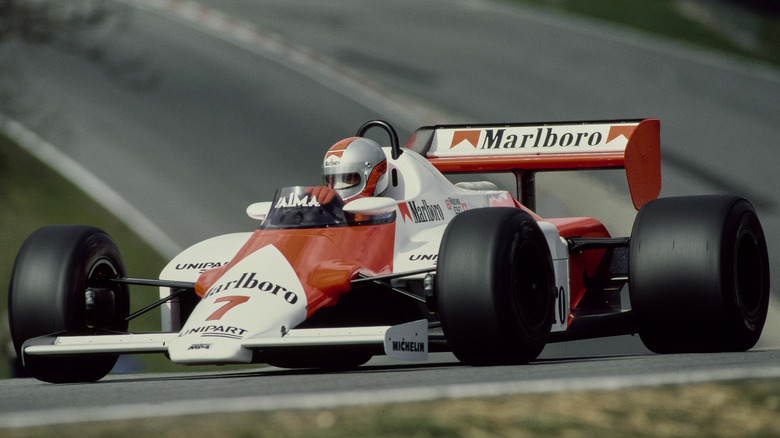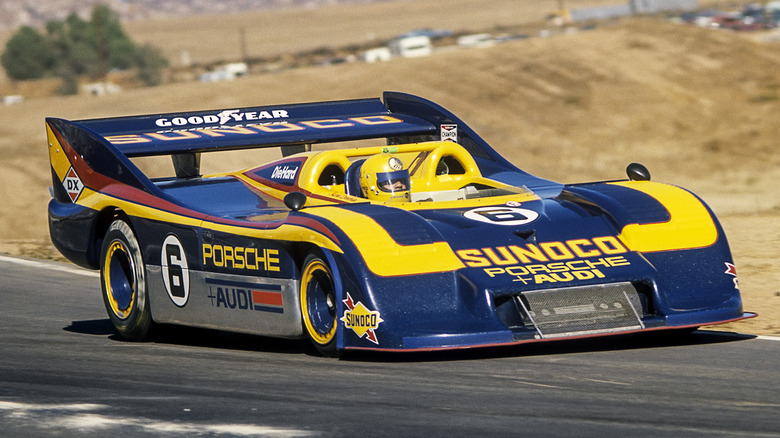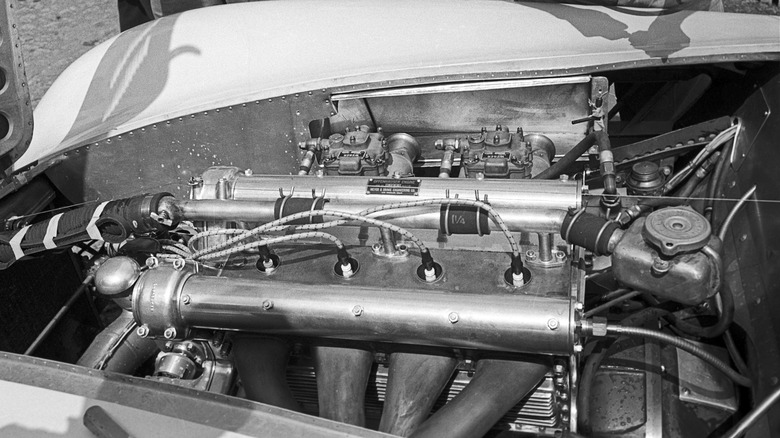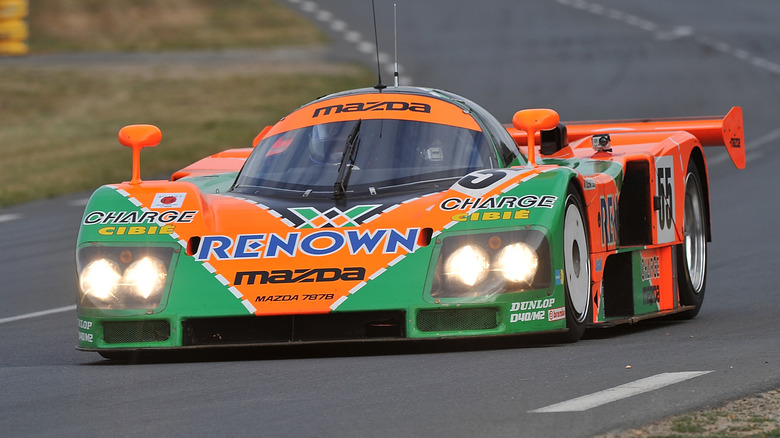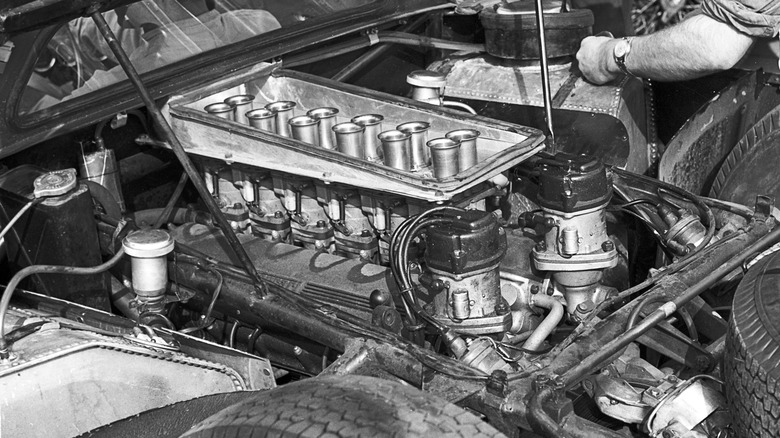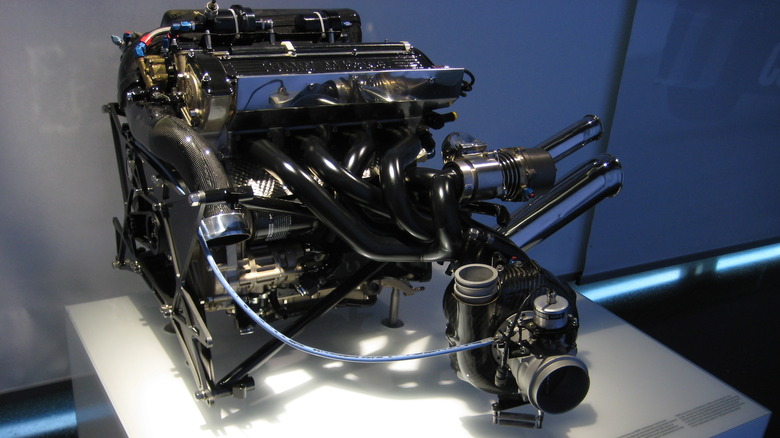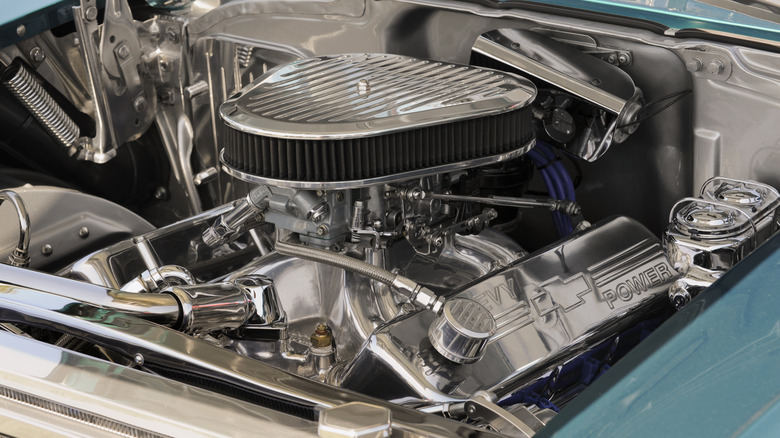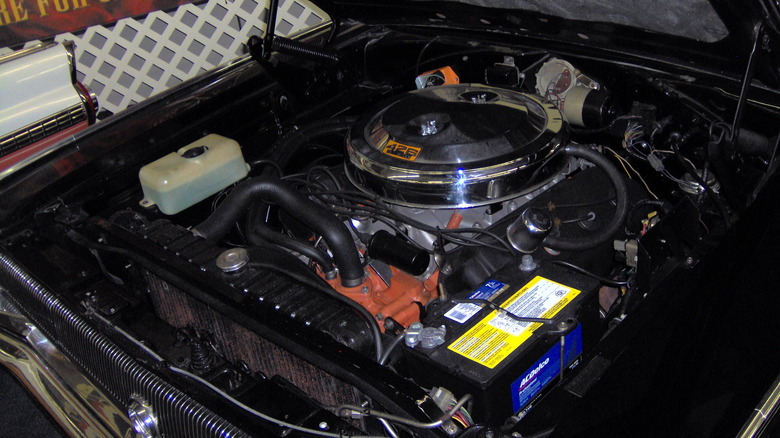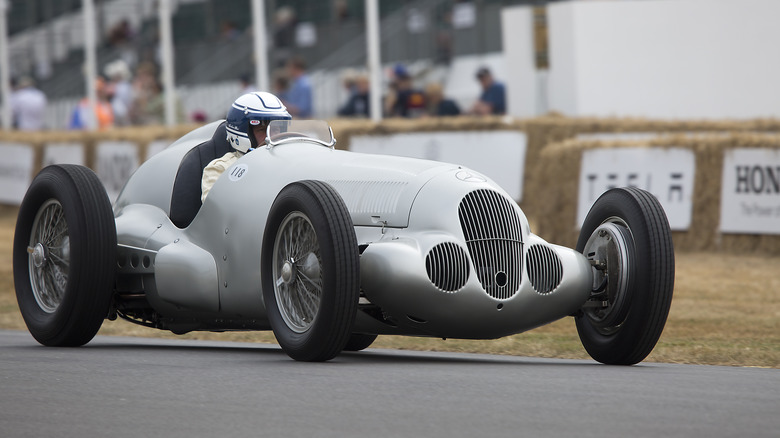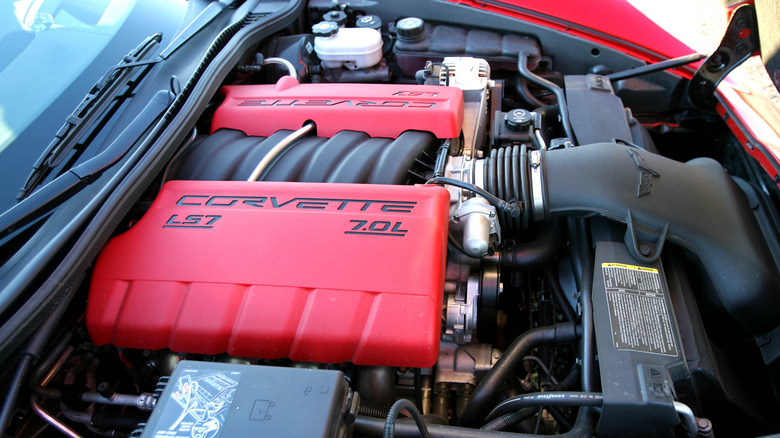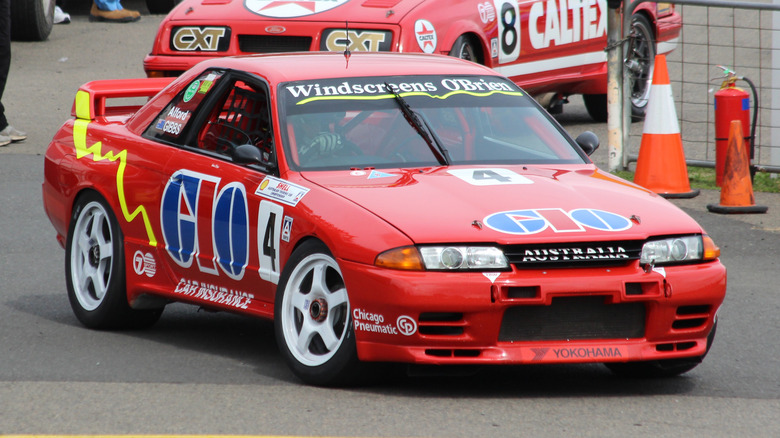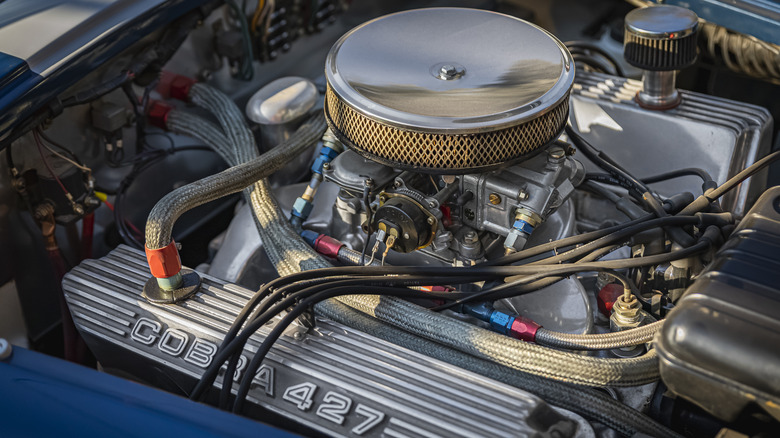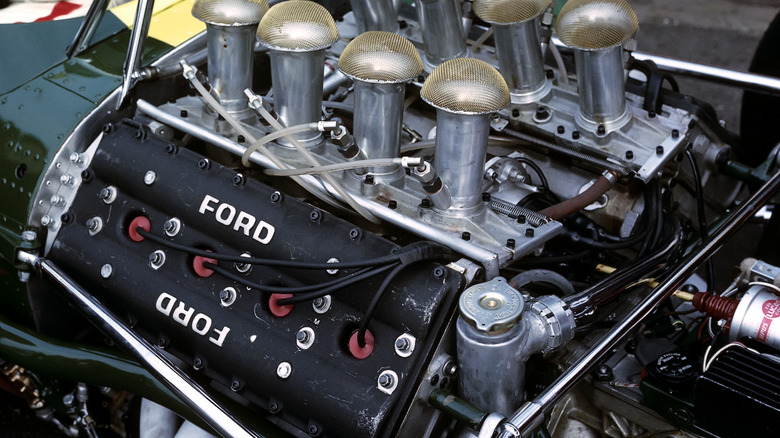12 Iconic Engines That Changed Racing Forever
The world's greatest race cars are nothing without the engines that power them. They dictate the success of an individual car in competition, but on rare occasions, they're so influential that they change the course of the entire competition itself. Be that a racing series changing its rules to ban a dominant engine or an engine being so popular it enables an entirely new set of competitions to flourish, these 12 engines all changed racing history.
In some cases, they changed the automotive landscape outside of racing, too. Aside from being a spectacle, some would argue that racing's greatest legacy is encouraging innovation in all aspects of a car's engineering, with many racing-derived technologies eventually finding their way into production cars. Many of the great racing engines featured here made just as much impact off the track as on it, providing the foundations for which some of the most revered road cars would be built, as well as enabling their racing counterparts to excel on track.
Porsche 917/30 Can-Am Flat-12
The Porsche 917 was an incredibly successful race car, winning so many races in Europe that it was banned by the FIA after the 1972 season. Left with a world-beating car and nowhere to race, Porsche looked to America, focusing its efforts on the Can-Am racing series in 1973. An earlier version of the 917 was already used in the series and had clinched the overall title the previous year, but for the '73 season, Porsche debuted its newest creation, the 917/30.
The car was powered by a 5.4-liter turbocharged 12-cylinder engine, making over 1,000 horsepower. It was an evolution of the existing 917 engine but boasted a larger displacement and improved turbocharger. Paired with 917/30's extra downforce, it proved unstoppable, with driver Mark Donohue winning six out of the eight races in the season. There was no respite for other manufacturers in the other two races either — they were both won by the older Porsche 917/10.
Porsche was simply unbeatable through 1973, leaving other manufacturers disinterested in continuing competition. With waning support and a recession in America, the series collapsed the following year. Porsche retired the 917 after withdrawing from Can-Am, leaving its exceptional 12-cylinder engine without a further series to compete in.
Miller-Offenhauser Inline-4
Originally developed by Harry Miller and his assistant Fred Offenhauser in the 1920s, their inline-4 engine design would prove to be one of the greatest in racing history. After Miller ran into financial trouble and had to close his shop in the Great Depression, Offenhauser bought the engine design and tools and continued production. In 1935, an Offy-powered car first won at the Indy 500, and it didn't take long for further titles to start rolling in. Offenhauser's engines won the race four times before the breakout of war in 1941 forced his shop to pivot to the production of military aircraft parts.
Shortly after the war ended, Offenhauser sold his business to Louis Meyer and Dale Drake, who continued producing the now-famous engine design with great success. An Offy inline-4 powered every Indy 500 winner from 1947 through to 1964, with its dominance so great that between 1950 and 1960, every podium place car ran the engine. Throughout the mid-to-late '60s, a new wave of competitors saw the Offenhauser lose its winning edge, save for a single win in 1968. However, further rule changes saw the engine regain that edge, winning consecutive titles again from 1972 to 1976. Its relevance eventually faded as further competitors emerged, but the Offy's 50-year reign remains unmatched by any other engine since.
Mazda R26B
No manufacturer is more closely associated with the rotary engine than Mazda. It had been using an adapted version of its 13B rotary in Japanese racing series since the '70s, and by 1979, had chosen to prove the rotary's worth at Le Mans, entering the RX-7 252i. Mazda saw limited success in its early years of entry but gradually improved its formula over the years to move higher up the leaderboard. However, the team was always seen as outsiders — rivals had bigger budgets, more experience, and more high-profile drivers.
The 1991 season was the last chance for Mazda to prove itself against the big players, as new rules coming into force for the 1992 season meant that rotary engines would be banned. After an underwhelming qualifying and subsequent 19th-place start, car 787B-002 fought its way through the pack, the team watching on anxiously as much of the competition suffered from mechanical failure or collisions, putting them out of contention. Mazda's car had no such issues, performing exactly as planned and eventually taking the top step of the podium.
Technically, only two of the three drivers made the podium — Johnny Herbert, the British driver who took the car across the finish line, was so exhausted that he needed medical attention immediately after the checkered flag and was taken to hospital. His efforts weren't in vain, though, as Mazda's iconic rotary engine had finally proved itself at endurance racing's premier event and just in the nick of time.
Ferrari Colombo V12
Arguably, Ferrari's legacy-defining engine, the Colombo V12, can be found powering many of the brand's most iconic classic race cars. It takes its name from its designer, Gioachino Colombo, and first appeared in the brand's first car, the 125 S, in 1947. In its initial configuration, its displacement was just 1.5-liter to comply with Formula 1 racing regulations. Over the years, it grew significantly in size and power, and by the time it was retired in 1989, the largest variant boasted a 4.9-liter displacement.
As well as the brand's original Formula 1 car, the Colombo V12 also powered racing greats such as the Ferrari 250 GTO and 250 GT Berlinetta. Perhaps the engine's most impressive feat was the variety of cars it appeared in. From stripped-out Le Mans endurance racers to luxurious grand tourers, it was suitable for just about any type of car Ferrari could create. With a production run spanning more than four decades, its longevity remains unmatched by any Ferrari engine since.
BMW M12/13
It might have debuted back in 1986, but the BMW M12/13 remains the most powerful Formula 1 engine ever built. It was created in response to a rule change by the FIA stating that not only were naturally aspirated engines banned from competition but that turbocharged engines were allowed unlimited boost during qualifying. Naturally, BMW sought to make the most of the change, producing an engine that, in its most potent form, was so powerful that its true output remains unknown. The team's dyno only went up to 1,280 horsepower, but the M12/13's output was estimated to be somewhere around 1,400 horsepower.
During the main race, the engine was dialed down to around 1,000 horsepower in an attempt to increase its reliability, but with little success. It suffered from persistent cooling problems and was less efficient than its rivals, leading BMW to withdraw its factory efforts after the 1986 season. However, Brabham continued to run the engine throughout 1987 until the escalating horsepower wars caused F1 to ban turbocharged cars a year later.
[Featured image by Buschtrommler via Wikimedia Commons | Cropped and scaled | CC BY-SA 3.0]
Chevrolet Mighty Mouse Small Block
The Chevy small block debuted for the 1955 model year and quickly became one of the most ubiquitous engines in America, powering everything from commercial vehicles to race cars. Its affordability, reliability, and tunability made it an instant hit with everyone from grassroots racers to industry professionals. NASCAR was one format where the small block was particularly competitive, securing its first win in 1955 and playing a critical part in helping Chevy become the most decorated manufacturer in the sport.
However, for every high-profile win, there were plenty more local and regional racers claiming trophies thanks to the small block's versatility. Although it's since been replaced by the LT and LS engines, it remains a favorite among enthusiasts, both in racing form and street builds. It might be far from the most exotic engine here, but there's no denying just how transformational Chevy's engine was — and its successors continue to be today.
Chrysler 426 Hemi
The 426 Hemi remains one of the greatest muscle V8 engines, but it was arguably too successful in racing for its own good, at least when it first debuted. After the rules changed in 1963 to allow larger engine displacements, Chrysler revamped its existing "Max Wedge" engine to take advantage. Armed with new heads borrowed from the brand's Indy racing efforts, the 426 Hemi was unleashed for the 1964 season and quickly proved unstoppable.
That year's Daytona 500 saw all four top spots taken by Hemi-powered cars, with NASCAR reacting by changing the rules for the following season to exclude engines without homologated production versions. The 426 Hemi was a race-only engine at that point, forcing Chrysler out of the 1965 season. The following year, however, the fight was back on, with the engine offered to the public in 1966 and remaining in dealerships until new emissions regulations killed it off in 1972.
[Featured image by Stephen Foskett via Wikimedia Commons | Cropped and scaled | CC BY-SA 3.0]
Mercedes-Benz M125
While its legacy is complicated because of its close association with the Third Reich, the Mercedes-Benz W125 was undeniably one of the most advanced race cars of its era. It was powered by the M125 5.6-liter supercharged inline-8 engine, which produced more than 580 horsepower, an astonishing figure for the era. It only competed for a single season in 1937, winning almost every race it entered until a rule change the following year cut its reign short.
It boasted performance figures that best even some modern supercars, reportedly reaching speeds of 211 mph during a race on the Avus circuit and clocking even higher figures during a record attempt. Other European rivals simply couldn't keep up with the car's unprecedented pace or match the output of its unprecedented engine. After being unceremoniously axed, the W125 was replaced by the equally successful W154, which would continue to dominate the racing circuit until the breakout of war in 1939.
GM LS V8
The LS V8 is a successor to the Chevy small block and is just as important for many grassroots and professional racing builds. LS swaps are among the most common engine swaps for good reason — they're affordable, with a large aftermarket, and can produce significantly more than their stock output with minimal modification. However, the LS is still different from the small blocks that came before it: it's almost entirely new, designed from the ground up to improve on its predecessor in every aspect.
It's a common sight in motorsport disciplines from drag racing to drifting, and despite being in production for over two and a half decades, builders are still finding new ways to get more power out of it. Even with the newer LT platform available, the LS remains the platform of choice for many as it's simply the most affordable way to generate high horsepower figures, and that looks set to continue for the foreseeable future.
Nissan RB26DETT Group A
The Skyline GT-R R32, or Godzilla, shocked the performance car world when it debuted. It was fast from the factory, but tuners quickly found its overbuilt internals could handle much more than its stock output. Australian touring car racing made full use of this potential, with the Group A Skyline so fast that Nismo effectively banned the team behind it from taking it international.
With a large budget and a determination to compete with the Fords and Holdens that were dominating the standings, the team upgraded the engine with a mix of Nismo and locally sourced parts until it made more than 700 horsepower. Its first full season was in 1991, and it quickly proved unbeatable, winning the title that year and repeating the feat in 1992. The success reportedly caught the eye of certain foreign teams, including those in Japan. However, in an interview with WhichCar, team boss Fred Gibson revealed Nismo blocked the Aussie Group A R32 from competing abroad. Allegedly, this was because it would have upstaged Nismo's own factory efforts.
Eventually, Skyline's unrivaled success in Australia made it largely disliked by local fans, and plenty of them celebrated when the rules were eventually changed to exclude it from competing. The new Supercar class rules mandated V8 engines, like those already used by Holden and Ford, while Nissan's inline-6 was no longer eligible for competition.
[Featured image by Kytabu via Wikimedia Commons | Cropped and scaled | CC BY-SA 4.0]
Ford 427 Big Block
The Ford GT40 remains the company's most valuable car by a considerable margin, and at its heart is one of Ford's greatest racing engines. The 427 cubic inch, or 7.0-liter, big block was far from a Le Mans special, though: it also saw service in everything from top fuel dragsters to the Shelby Cobra. While the GT40 sported a 427 with a conventional design, a "Cammer" overhead cam variant was also developed for NASCAR.
Ford wanted an engine to rival the 426 Hemi that was dominating the championship and saw its Cammer design as a way to get ahead of the competition. Unfortunately, NASCAR's ban on race-only engines saw it excluded alongside the Hemi, but it later saw some success in drag racing. Although it was never able to prove its full potential on oval circuits, the 427 Big Block remains a racing legend, being one of the only American powerplants to take the fight to the Europeans on their home turf and win.
Cosworth DFV
Considered by some to be the most successful racing engine ever made, the Cosworth DFV dominated Formula 1, taking back-to-back wins between 1968 and 1974. In 1975, it won at Le Mans, then repeated the feat in 1980, while a turbocharged version of the engine also racked up 10 wins at the Indy 500. What made these feats even more unprecedented was that the engine's designer had never developed a Grand Prix engine before. In fact, he'd never designed an engine from the ground up at all.
The DFV differed from its competition in several key ways: it was designed as a stressed member of the chassis and focused on reducing weight as much as adding power. It took Cosworth's chief engineer just nine months to develop from scratch and won upon its debut in 1967. Initially, it suffered from reliability issues, but those were quickly straightened out, and before long, the DFV could be found in the majority of Formula 1 cars on any given grid.
And, perhaps most importantly, at the top of the standings when the race had finished. Very few engines can claim to be winners in three of the world's most competitive motorsport disciplines. But the DFV simply stood above the rest, cementing its place as one of the most iconic engines of all time.
